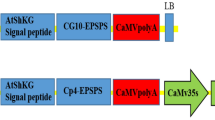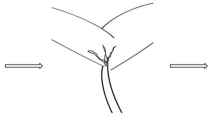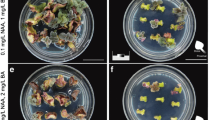Abstract
Soybean transformation by ovary-drip was improved by optimizing the length of the transformation pathway by cutting the styles. These modifications facilitated soybean transformation manipulation and improved transformation reproducibility and efficiency. Using a linear minimal gus gene cassette as the foreign DNA, a maximum transformation frequency of 11% was obtained in flowers of the soybean cultivar ‘Liaodou 14’ with their styles mostly removed, whereas removal of only the stigma, partial style cutting and partial ovary cutting gave transformation frequencies of 0%, 1%, and 2%, respectively. An average transformation frequency of 8.2% was obtained when 619 flowers from three soybean cultivars (‘Liaodou 14’, ‘Liaodou 13’, and ‘Tiefeng 29’) were transformed by this optimized method. Southern blotting analysis showed that the gus reporter gene (encoding β-glucuronidase) was stably inherited with a simple pattern. Reverse transcription-polymerase chain reaction (RT-PCR) and GUS staining confirmed the expression of the gus gene in transgenic plants.
Similar content being viewed by others
References
Bechtold, N., Jaudeau, B., Jolivet, S., Maba, B., Vezon, D., Voisin, R., Pelletier, G., 2000. The maternal chromosome set is the target of the T-DNA in the in planta transformation of Arabidopsis thaliana. Genetics, 155(4): 1875–1887.
Bent, A.F., 2000. Arabidopsis in planta transformation. Uses, mechanisms, and prospects for transformation of other species. Plant Physiol., 124(4):1540–1547. [doi:10.1104/pp.124.4.1540]
Bent, A.F., 2006. Arabidopsis thaliana floral dip transformation method. Methods Mol. Biol., 343:87–103. [doi:10.1385/1-59745-130-4:87]
Chabaud, M., Ratet, P., de Sousa Araújo, S., Roldão Lopes Amaral Duque, A.S., Harrison, M., Barker, D.G., 2007. Agrobacterium tumefaciens-Mediated Transformation and in vitro Plant Regeneration of M. truncatula. Available from http://www.noble.org/MedicagoHandbook [Accessed on Oct. 8, 2009]
Cheng, Y.Q., Yang, J., Xu, F.P., An, L.J., Liu, J.F., Chen, Z.W., 2009. Transient expression of minimum linear gene cassettes in onion epidermal cells via direct transformation. Appl. Biochem. Biotechnol., 159(3):739–749. [doi:10.1007/s12010-009-8554-7]
Clough, S.J., Bent, A.F., 1998. Floral dip: a simplified method for Agrobacterium-mediated transformation of Arabidopsis thaliana. Plant J., 16(6):735–743. [doi:10.1046/j.1365-313x.1998.00343.x]
Desfeux, C., Clough, S.J., Bent, A.F., 2000. Female reproductive tissues are the primary target of Agrobacterium-mediated transformation by the Arabidopsis floraldip method. Plant Physiol., 123(3):895–904. [doi:10.1104/pp.123.3.895]
Droste, A., Pasquali, G., Bodanese-Zanettini, H.M., 2002. Transgenic fertile plants of soybean [Glycine max (L.) Merrill] obtained from bombarded embryogenic tissue. Euphytica, 127(3):367–376. [doi:10.1023/A:1020370913140]
Gao, X.R., Wang, G.K., SU, Q., Wang, Y., AN, L.J., 2007. Phytase expression in transgenic soybeans: stable transformation with a vector-less construct. Biotechnol. Lett., 29(11):1781–1787. [doi:10.1007/s10529-007-9439-x]
Hu, C.Y., Wang, L.Z., 1999. In planta soybean transformation technologies developed in China: procedure, confirmation and field performance. In Vitro Cell. Dev. Biol. Plant, 35(5):417–420. [doi:10.1007/s11627-999-0058-1]
Jefferson, R.A., 1987. Assaying chimeric genes in plants: the GUS gene fusion system. Plant Mol. Biol. Rep., 5(4): 387–405. [doi:10.1007/BF02667740]
Liu, J.F., Su, Q., An, L.J., Yang, A.F., 2009. Transfer of a minimal linear marker-free and vector-free smGFP cassette into soybean via ovary-drip transformation. Biotechnol. Lett., 31(2):295–303. [doi:10.1007/s10529-008-9851-x]
McCabe, D.E., Swain, W.F., Martinell, B.J., Christou, P., 1988. Stable transformation of soybean (Glycine max) by particle acceleration. Bio/Technology, 6(8):923–926. [doi: 10.1038/nbt0888-923]
Mello-Farias, P., Chaves, A., 2008. Advances in Agrobacterium-mediated plant transformation with emphasis on soybean. Sci. Agric. (Piracicaba, Braz.), 65(1):95–106. [doi:10.1590/S0103-90162008000100014]
Murray, M.G., Thompson, W.F., 1980. Rapid isolation of high molecular weight plant DNA. Nucleic Acids. Res., 8(19):4321–4325. [doi:10.1093/nar/8.19.4321]
Paz, M.M., Shou, H., Guo, Z., Zhang, Z., Banerjee, A.K., Wang, K., 2004. Assessment of conditions affecting Agrobacterium-mediated soybean transformation using the cotyledonary node explant. Euphytica, 136(2): 167–179. [doi:10.1023/B:EUPH.0000030669.75809.dc]
Paz, M.M., Martinez, J.C., Kalvig, A.B., Fonger, T.M., Wang, K., 2006. Improved cotyledonary node method using an alternative explant derived from mature seed for efficient Agrobacterium-mediated soybean transformation. Plant Cell Rep., 25(3):206–213. [doi:10.1007/s00299-005-0048-7]
Sambrook, J., Tritsch, E.F., Maniatis, T., 1989. Molecular Cloning: A Laboratory Manual, 2nd Ed. Cold Spring Harbor Laboratory Press, Cold Spring Harbor, New York.
Santarém, E.R., Finer, J.J., 1999. Transformation of soybean (Glycine max (L.) Merrill) using proliferative embryogenic tissue maintained on semi-solid medium. In Vitro Cell. Dev. Biol. Plant, 35(6):451–455. [doi:10.1007/s11627-999-0067-0]
Sato, S., Newell, C., Kolacz, K., Tredo, L., Finer, J.J., Hinchee, M., 1993. Stable transformation via particle bombardment in two different soybean regeneration systems. Plant Cell Rep., 12(7–8):408–413. [doi:10.1007/BF00234702]
Trieu, A.T., Burleigh, S.H., Kardailsky, I.V., Maldonado-Mendoza, I.E., Versaw, W.K., Blaylock, L.A., Shin, H., Chiou, T.J., Katagi, H., Dewbre, G.R., Weigel, D., Harrison, M.J., 2000. Transformation of Medicago truncatula via infiltration of seedlings or flowering plants with Agrobacterium. Plant J., 22(6):531–541. [doi:10.1046/j.1365-313x.2000.00757.x]
Wu, W., Su, Q., Xia, X.Y., Wang, Y., Luan, Y.S., An, L.J., 2008. The Suaeda liaotungensis Kitag betaine aldehyde dehydrogenase gene improves salt tolerance of transgenic maize mediated with minimum linear length of DNA fragment. Euphytica, 159(1–2):17–25. [doi:10.1007/s10681-007-9451-1]
Xue, R.G., Xie, H.F., Zhang, B., 2006. A multi-needle-assisted transformation of soybean cotyledonary node cells. Biotechnol. Lett., 28(19):1551–1557. [doi:10.1007/s10529-006-9123-6]
Yang, A.F., Su, Q., An, L.J., Liu, J.F., Wu, W., Qiu, Z., 2009a. Detection of vector- and selectable marker-free transgenic maize with a linear GFP cassette transformation via the pollen-tube pathway. J. Biotechnol., 139(1):1–5. [doi:10.1016/j.jbiotec.2008.08.012]
Yang, A.F., Su, Q., An, L., 2009b. Ovary-drip transformation: a simple method for directly generating vector- and marker-free transgenic maize (Zea mays L.) with a linear GFP cassette transformation. Planta, 229(4):793–801. [doi:10.1007/s00425-008-0871-5]
Ye, G.N., Stone, D., Pang, S.Z., Creely, W., Gonzalez, K., Hinchee, M., 1999. Arabidopsis ovule is the target for Agrobacterium in planta vacuum infiltration transformation. Plant J., 19(3):249–257. [doi:10.1046/j.1365-313X.1999.00520.x]
Zhang, X., Henriques, R., Lin, S.S., Niu, Q.W., Chua, N.H., 2006. Agrobacterium-mediated transformation of Arabidopsis thaliana using the floral dip method. Nat. Protoc., 1(2):641–646. [doi:10.1038/nprot.2006.97]
Author information
Authors and Affiliations
Corresponding authors
Additional information
Project (No. JY03-B-18-02) supported by the National R & D Project of Transgenic Crops of Ministry of Science and Technology of China
Rights and permissions
About this article
Cite this article
Liu, M., Yang, J., Cheng, Yq. et al. Optimization of soybean (Glycine max (L.) Merrill) in planta ovary transformation using a linear minimal gus gene cassette. J. Zhejiang Univ. Sci. B 10, 870–876 (2009). https://doi.org/10.1631/jzus.B0920204
Received:
Accepted:
Published:
Issue Date:
DOI: https://doi.org/10.1631/jzus.B0920204
Key words
- Soybean
- Glycine max (L.) Merrill
- In planta ovary-drip transformation
- Optimization
- Style cutting
- Minimal gus reporter gene cassette




